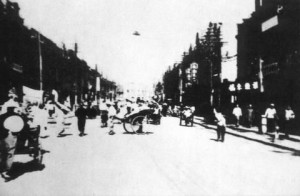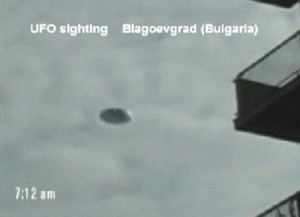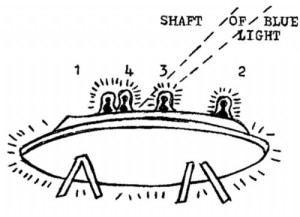THINK ABOUTIT LANDING REPORT
Date: April 23, 1966
Sighting Time: 2:10 a.m.
Day/Night: Night
Location: Route #2 in Yorktown, a few miles west of Clarinda, Iowa
Urban or Rural: Rural
Hynek Classification: CE-II (Close Encounter II) Observation of an object in close proximity to the witness, where physical traces (impression, burn, medical effect, etc.) are left or (electrical effect, heat) are felt
Duration: 20 minutes
No. of Object(s): 1
Size of Object(s): 60 feet in length
Distance to Object(s): 50 feet
Shape of Object(s): cigar-shaped
Color of Object(s): dull finish, “blood red” glow
Number of Witnesses: 1
Source: http://www.nicap.org/newlook/section_VI.htm
Summary/Description: At 2:10 a.m. on the morning of April 23, Ronald E. Johnson, a farmer living on Route #2 in Yorktown, a few miles west of Clarinda, Iowa, was awakened by a loud roar. On getting up and going to his window, which faced south, he saw a cigar-shaped object, approximately 60 feet in length, landing in a field within 50 feet of his house.
Full Report
At 2:10 a.m. on the morning of April 23, Ronald E. Johnson, a farmer living on Route #2 in Yorktown, a few miles west of Clarinda, Iowa, was awakened by a loud roar. On getting up and going to his window, which faced south, he saw a cigar-shaped object, approximately 60 feet in length, landing in a field within 50 feet of his house.
The object, which had apparently come out of the north, came into view as it moved over the house. The night was foggy and a light rain was falling at the time. No moon or stars were visible. The roar of the object ceased as it landed. On the end of the object closest to the house, Johnson saw a brilliant red light, which bathed the area in a “blood red” glow. On the farthest end, he saw two blue lights approximately eight inches in diameter, which extended above the body of the object. The surface of the object was of a dull finish, except for an amber glow that extended partway along the bottom. The object rested on a series of from 17 to 20 long “legs.”
After landing, the object gave off a series of loud, explosive, “cracking” noises, like gunshots, at regular intervals. Johnson said the air was filled with an odor which he described as similar to ozone. He saw nothing leaving or entering the object. He watched it sitting motionless in his field for about 20 minutes and finally went back to bed. He got up a short time later to see if it was still there, but it had either departed silently or had turned out its lights. The explosive sounds were no longer heard.
In the morning, Johnson discovered that sometime during the night his livestock had all bolted to the far end of the pasture and appeared to be “acting up considerably.” They would not return for feeding that morning. Examining the landing site he found a series of circular impressions six inches in diameter and spaced alternately in two rows. The distance between impressions was two and a half feet. To the east of the landing impressions, he found a second set of imprints, round on one side and square-edged on the other, and divided at the squared-off edge into three sections (see diagram). These impressions were not made by his cattle, according to the farmer.
One other peculiar detail was noticed: two power line poles appeared to have fresh depressions in the wood at regular intervals as if it had been recently climbed. The poles were smeared with dirt. Wires rising on the poles had small, regular-spaced notches. Johnson reported the incident to Deputy Sheriff Dick Hunt, who made an investigation. A complete report was said to have been sent to Offut Air Force base; however, Johnson was not queried by any official investigators, and if the report is among those in the official files, it was not released to the University of Colorado, who requested information on it in July 1967.
Additional details were obtained for NICAP by member Dennis Hicks.



Related Reports
Iowa Map of all Sightings
1920: UFO Landing, Mount Pleasant, Iowa
1954: Osceola, Iowa Abduction